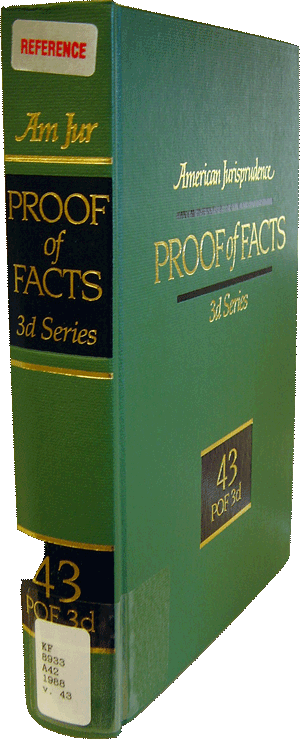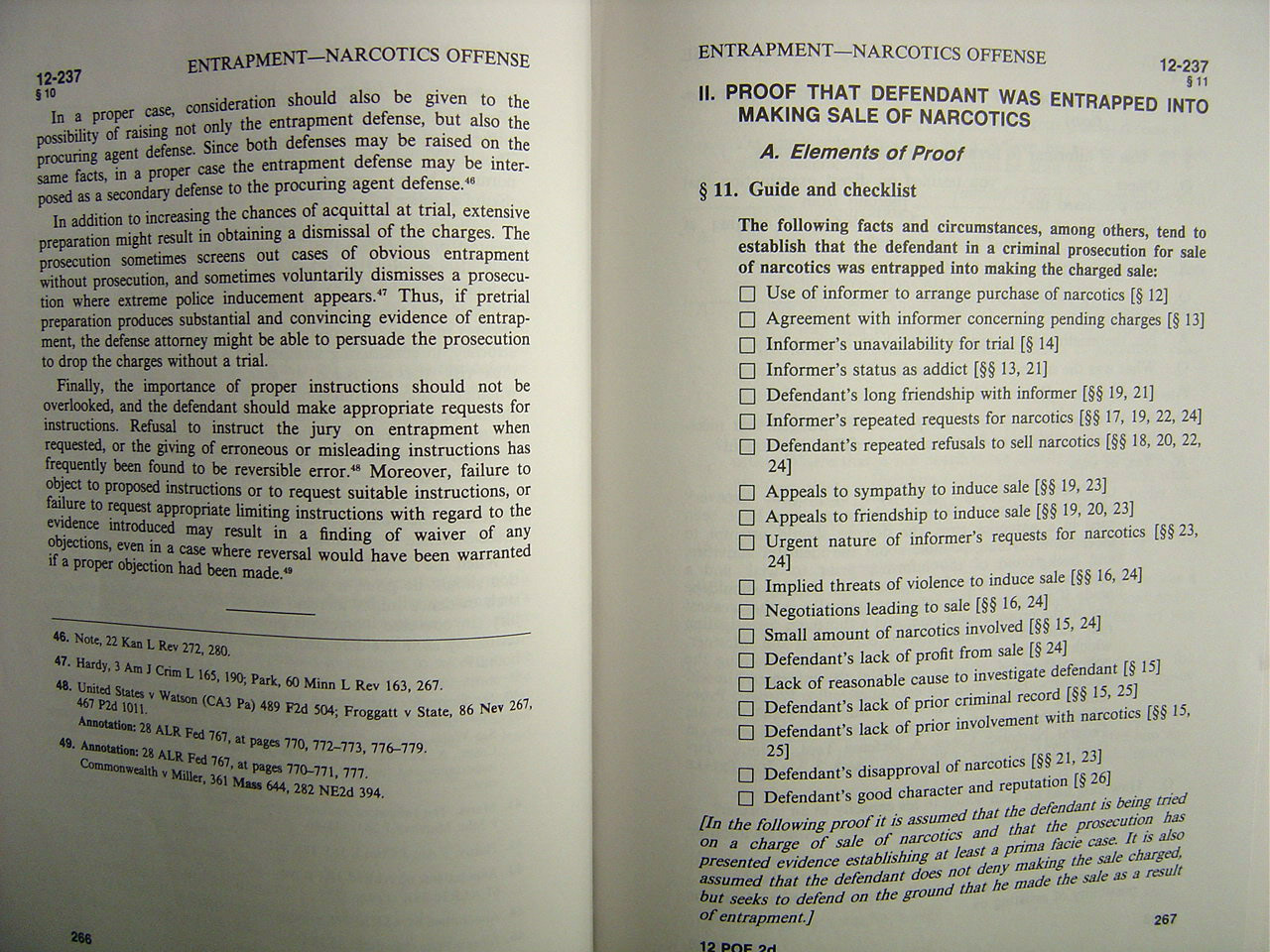

Am. Jur. Proof of Facts (POF) is a legal form book legal reference book with checklists, forms, and examples of documents and procedures; a legal how-to book by Lawyer’s Cooperative Publishing Company. It is unlike any other form book legal reference book with checklists, forms, and examples of documents and procedures; a legal how-to book . In fact, it does just what it claims: it sets forth the facts that will have to be proved at trial, then tells the researcher just how to establish to prove those facts, or how to challenge to object facts alleged by the opposition. POF provides the standards for which facts must be proven at trial in order An official command by the court, usually demanding that one or both of the parties perform an act. to succeed. It provides traditional research tools, as well as those found nowhere, but in Proof of Facts.
Following is a guide to utilizing Am.Jur. Proof of Facts.
The Index
The researcher begins in the Proof of Facts General Index (POF). There is a single index that covers all the POF series. The index leads the researcher to a volume, series, page, and sometimes a section within the main volumes. This leads the researcher to an "article."
The Article
POF utilizes several research tools, but not all are in every article that is found. Following are some of the tools provided within POF:

* Index to the POF Article
This index will lead only to points within the article itself.
* Total Client Service The presentation of legal papers. Library
This is the research system developed by the publisher of POF, and other books, Lawyer’s Cooperative Publishing Company.
* The Article
The article typically provides extensive commentary, including detailed discussion on the topic being researched, as well as references to other authorities.
* Sample Examination questioning witnesses, generally under oath Questions
These are fantastic sources for developing interview questions, interrogatories written questions to a party that must be answered under oath (example: “Describe the events that led up to the accident.”) , or even preparing deposition oral questions that must be answered under oath. Depositions usually take place out of court, often in an attorney’s office with a court reporter transcribing the testimony. Attorneys from both sides must be present; both have the opportunity to ask questions. Depositions can be for the purpose of questioning the opposing party or for questioning witnesses. Videotaped and audiotaped depositions are sometimes taken. or trial examination questioning witnesses, generally under oath questions for the attorney. POF may even provide anticipated responses to examination questioning witnesses, generally under oath questions.
* Illustrations
These examples are provided to help the researcher anticipate
various situations.
* Checklists
A wonderful resource, if it is provided. Helps to organize the entire litigation a law suit process.
* Specific Elements that Must Be Proven
This is very useful in helping the attorney establish to prove a prima facie case a legal dispute. Case sometimes means the matter on which an attorney or paralegal are working for the client, as in “our client’s case is going to trial next week.” The word may also refer to an opinion, which is a written decision of the court, such as Roe v. Wade , but also may help the paralegal a non-lawyer performing tasks that require specific legal skills, usually under the supervision of an attorney prepare everything from the Complaint the pleading that initiates the legal action and sets forth the general allegations against the defendant. The plaintiff does not argue his entire case in the complaint, but sets forth his claim in a skeletal fashion. The complaint is usually served with the summons in some states, a complaint is called a petition or motion for judgment to discovery the devices whereby one party obtains relevant case information from the other party. Used to even the playing field between parties by exposing all relevant facts upon which the court will ultimately base its decision. Discovery is generally between the parties and does not directly involve the court, although the certificate of mailing for each document is often filed. Methods of discovery include interrogatories, requests for admissions, requests for production of documents, requests for mental or physical examination and depositions. documents.
* Model Discovery the devices whereby one party obtains relevant case information from the other party. Used to even the playing field between parties by exposing all relevant facts upon which the court will ultimately base its decision. Discovery is generally between the parties and does not directly involve the court, although the certificate of mailing for each document is often filed. Methods of discovery include interrogatories, requests for admissions, requests for production of documents, requests for mental or physical examination and depositions.
Examples of discovery the devices whereby one party obtains relevant case information from the other party. Used to even the playing field between parties by exposing all relevant facts upon which the court will ultimately base its decision. Discovery is generally between the parties and does not directly involve the court, although the certificate of mailing for each document is often filed. Methods of discovery include interrogatories, requests for admissions, requests for production of documents, requests for mental or physical examination and depositions. documents. Obviously, very useful.
* Model Pleadings legal documents filed with the court asking it to take some sort of action. In most cases, the party filing the document must send a copy to the other party or parties to give them ample opportunity to respond. The major pleadings are the complaint, answer, affirmative defense, counterclaim, cross-claim and the reply.
Examples of pleadings legal documents filed with the court asking it to take some sort of action. In most cases, the party filing the document must send a copy to the other party or parties to give them ample opportunity to respond. The major pleadings are the complaint, answer, affirmative defense, counterclaim, cross-claim and the reply. . Again, very helpful.
The Supplements
Am.Jur. Proof of Facts updates the main volumes with supplements, or pocket parts, found in the back of each individual volume. Be sure to check the pocket part a supplement in the back of a volume that alters or adds to material contained in the hardbound volume. When information from previous pocket parts is combined with new information, the pocket part may be referred to as a cumulative supplement. See cumulative and supplement to make sure you have the most up to date information ...1) obtained facts. 2) a document that alleges that a defendant has committed a crime, as opposed to an indictment by a grand jury on your topic. Just look up the same page number in the pocket part a supplement in the back of a volume that alters or adds to material contained in the hardbound volume. When information from previous pocket parts is combined with new information, the pocket part may be referred to as a cumulative supplement. See cumulative and supplement .
Am.Jur. POF Fact Book
This single-volume book, the Am.Jur. POF Fact Book, provides hundreds of fascinating facts, from how to properly amputate an arm to how far apart airplanes should be when they’re landing. In addition, in the back of the Fact Book you will find a wonderful Medical Glossary. While your topic may not be covered in the fact book, it’s worth it just to take a look!
Copyright 2008
All Rights Reserved
by